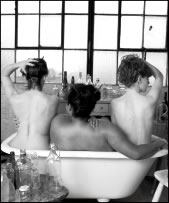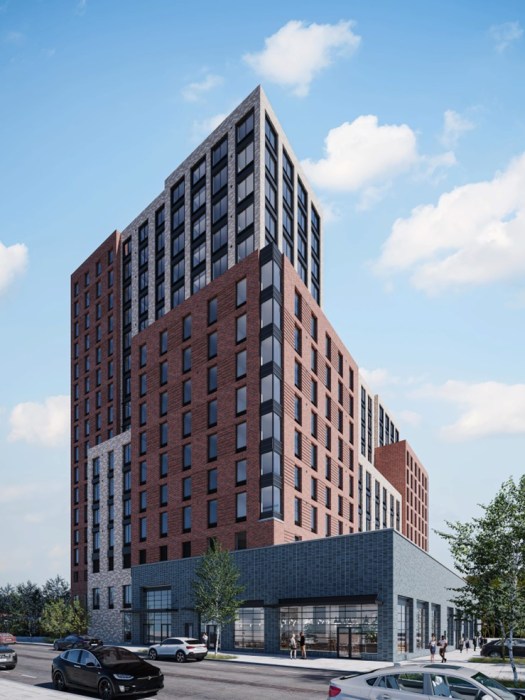BY STEVEN SNYDER
Unconventional artists engage audience through their own neutrality
This is not theater as you know it — and the New York Neo-Futurists like it that way.
Since the group’s inception, its goal has been to tear down the artifice of the conventional theater experience; to conceive a whole new way of acting, watching and thinking about the stage from the ground up. “We follow in the footsteps of the Italian futurists, who worked to redefine the relationship between the audience and the performer by embracing the mechanization that was sweeping Italy at the time. They did it to comment on this revolution of machines and rituals in a world where so much was happening at once,” says Rob Neill, the Neo-Futurists’ managing director. “We do the same thing in our own time, feeding off the energy and diversity of the East Village, challenging the preconceptions of this Off-Broadway audience by getting into their face, asking them to join in the production, allowing them to direct the action.” In the early 1990s, the initial Neo-Futurists group was founded in Chicago, with members of that troupe trekking to New York later that decade in a short-lived bid to plant some neo-futurist roots in the soil of the Big Apple. It was in 2004, though, that a second attempt finally took hold — with a stable group of actors organizing Neo-Futurist shows at venues across Manhattan. For more than three years now, the New York Neo-Futurists have made the Kraine Theater (85 East Fourth Street) their home base, gaining a reputation for their weekly performances of the program “Too Much Light Makes the Baby Go Blind,” which takes to the stage at 10:30 p.m. every Friday and Saturday evening. “This is really our staple, and it’s something you have to see to believe: You get 30 original plays performed in 60 minutes, and they are all plays that are determined by the audience,” Neill says. “You get a menu of plays when you walk in the door, and you order the number of what you want to see, and the performers have the scripts and we never know what play is coming next. Because of this, every time you come it’s a different show, and we can approach a lot of different subjects in a lot of different ways, all in shorter plays of varying lengths. It’s wild, unpredictable mix of concepts, structures and themes.” It was at a “Too Much Light Makes the Baby Go Blind” performance where the concept for the Neo-Futurists’ latest feature-length production was sparked. “Erica Livingston and I did a short play about cat-calling and racism, where we compared racist slurs to sexist slurs, and it was very controversial and much discussed,” says Neo-Futurists member Cara Francis “We expanded on that, and took many of our ideas about sexism and feminism and put our different ideas together to see how they would reflect off each other.” After honing those short plays, and collaborating on a longer adaptation, Francis and Livingston — along with Desiree Burch — arrived at the basic, beguiling premise for “The Soup Show” (which will run from March 4 through the 27 at Here Arts Center). Pegged to Women’s History Month and directed by Laura Salierno, “The Soup Show” confronts issues of feminism and the shifting realities of the female experience, all through a format modeled after the medicine shows of the 19th century. In true Neo-Futurist fashion, they prefer you dub it a “neo-medicine show. “The basic concept of Neo-Futurists is that we are not playing characters but we are neutral; we are ourselves. This show explores that through the construct of a medicine show, where we are hawking our miracle product just like a snake-oil salesman,” says Francis, “Soup Show” co-writer and co-star. “The twist, though, is that the product we’re hawking is feminism, or rather the argument of feminism, presented from all the different viewpoints that show just how wide a concept it is. We’re trying to bring this concept into a current place, where we three women try to present not just our own outlooks, but the opinions of other women too. What does feminism mean today?” Reaching out to interview a wide array of almost four-dozen subjects — men and women, traditional and radical, young and old, gay and straight — Francis and her co-stars have developed a rather ingenious structure for “The Soup Show.” All three will be part of a soup recipe, immersing themselves in a bath onstage, soaking in water which will then be stirred, bottled and re-filled as the show progresses. It’s this bottled water that will be sold to the audience, as a miracle product for nine different purposes — from a broth to a perfume, an elixir and even birth control. Behind each use is a deeper feminist analysis about women’s place in society. “The goal is to touch on each of these concepts, from healing to health care — with the original place of women as healers — to then birth control, which brings up all the issues of sex, birthing and midwifery,” Francis says. “What we’re really addressing is female archetypes. We even present the woman as freak. Medicine shows would often have a freak as part of the whole package, and so we address that very fact, how women have also been described as witches or ‘the other.’ “ If the message sounds dramatic, the context is nothing short of audacious. Francis and her fellow performances will be nude through a portion of the program. She says the decision is an extension of the Neo-Futurist mantra — to create the ultimate expression of neutrality. “We are naked for most of the show, and we’re putting the idea of nudity and the naked body out there as a place of neutrality, to really get back to the idea of a person, which is obscured in most theater under the guise of character or performance.” Over the group’s three years in the East Village, audiences have increasingly warmed to this concept of breaking down the rules, structure and pageantry of conventional stage acting.
Neill says that something of a regular crowd has started to make its way out to the weekend “Too Much Light” performances, and that the lines extending out onto East 4th Street those nights have in turn attracted the attention of even more neighborhood residents and passersby. Neill says there is no better place in all of Manhattan to be a groundbreaking arts group. “The Village is constantly in flux, and there so many arts groups here that it creates this vibrancy you just can’t find anywhere else. Most recently, things like the Fourth Arts Block has become this great support network for us, creating some common goals in publicizing and recognizing art,” he says. “As we’ve settled in, this neighborhood has enabled us to do so much more. We perform more on the streets, the lines out the doors on a Friday night helps us to attract more attention, area residents have started to discover us more and more…if you want to be doing the sort of experimental things we are, you can’t ask for a more supportive hub of activity and curiosity.”


















